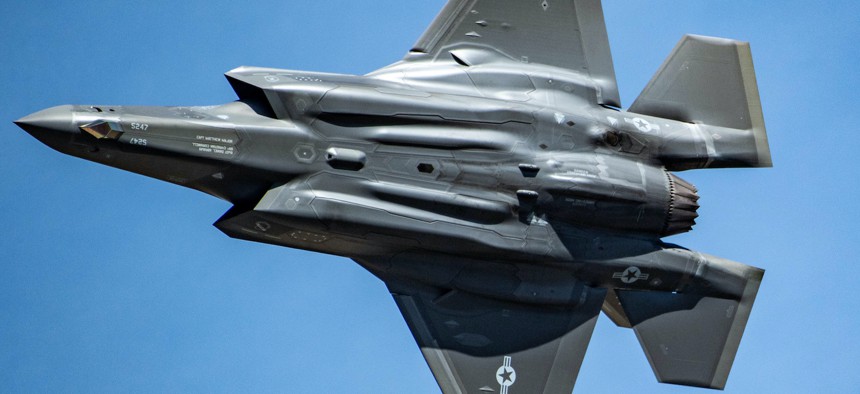
U.S. Air Force Maj. Kristin Wolfe performs a demonstration in the F-35A Lightning II during at the Reno Air Races in Reno, Nevada, September 19, 2021. U.S. Air Force / Tech. Sgt. Nicolas Myers
F-35s Need More Powerful Engines—But How Much More?
The Pentagon says it doesn’t know, and lawmakers have questions.
As the Pentagon funds an engine upgrade for its entire F-35 fleet, the Joint Program Office says it knows the current engine doesn’t have enough power—but doesn’t know how much more power it will actually need.
The F-35’s current Pratt & Whitney engine is running twice as hot as it was designed—driving the aircraft to require maintenance earlier, which runs up program costs.
“We have been eating into the life of this engine since the beginning of the program because we did under-spec the engine and its requirements,” F-35 Program Executive Officer Lt. Gen. Michael Schmidt said in a House Armed Services tactical air and land forces subcommittee hearing Wednesday.
However, the Pentagon’s efforts to upgrade the F135 engine lack “key elements of a full business case to support decisions and are proceeding without requirements,” Jon Ludwigson, director of contracting and national security acquisitions at the Government Accountability Office, said during the hearing.
Schmidt said that the program does have a power requirement, but said that GAO “makes a good point” that the service doesn’t know specifically what the “high-end margin” of power should be for the joint strike fighter.
“Those are discussions that we're having with services: how much margin do we want to build to, and we are working through the acquisition strategy and all the technical rigor that would be required for me to sign up to an acquisition program baseline and make a full commitment to the schedule and the technical requirements of the program," Schmidt said.
The upgrade, which will have a “normal depot cycle”—meaning it would need less maintenance than the current configuration—won’t reach the fleet until between 2030 and 2032, so JPO will have to keep paying for costly depot visits until then.
“We're planning to operate them [until] 2088. When you send an engine back more times than it was supposed to over [its] life...it is a huge amount of money that is going to cost us to refurbish these engines many extra times,” Schmidt told Defense One.
The JPO was unable to immediately provide the cost of an F-35 engine overhaul.
The program office will continue to work on its acquisition strategy to upgrade the F-35 engine and power and thermal management system “over the next few months,” according to Schmidt’s written testimony.
The Air Force recently decided it will upgrade the existing Pratt engines through a program called engine core upgrade, or ECU, and not pursue a new, adaptive engine for its F-35 fleet. The service wants to spend $254 million in 2024 for the ECU program, according to its 2024 budget request sent to Congress in early March.
But lawmakers aren’t sold on abandoning the adaptive engine for the F-35 fleet.
Rep. Rob Wittman, R-Va., chairman of the subcommittee, said lawmakers can’t “relitigate” the decision to go with ECU, but promised that lawmakers will continue to debate this issue in future hearings.
“Our job is to make sure that we fully gather every significant piece of information in both situations, ECU and AETP, to make sure that our subcommittee members, as well as the full committee members, have full awareness of all that information,” Wittman said Wednesday.
Other service leaders during the hearing emphasized what Air Force Secretary Frank Kendall previously said about ECU: The Pentagon needs an engine for all variants of the F-35.
"The ability to have a single solution across the Navy and Marine Corps aircraft inventory is critically important to us,” said Jay Stefany, who is performing the duties of assistant Navy secretary for research, development, and acquisition, and senior acquisition executive for the F-35 program.
Meanwhile, Wittman questioned the Air Force’s overall fighter acquisition plan—saying that the service “has yet to figure out how they will buy 1,763 F-35A aircraft after acknowledging their major operating cost assumption of $4.1 million per aircraft per year is unachievable.”
Between fiscal 2023 and 2028, the service plans to retire 801 fighters while buying only 345 new F-35A and F-15EX jets, Wittman said. He also noted the service’s 200 planned Next Generation Air Dominance fighters are “many years away from fielding” and will cost “hundreds of millions of dollars” each.




